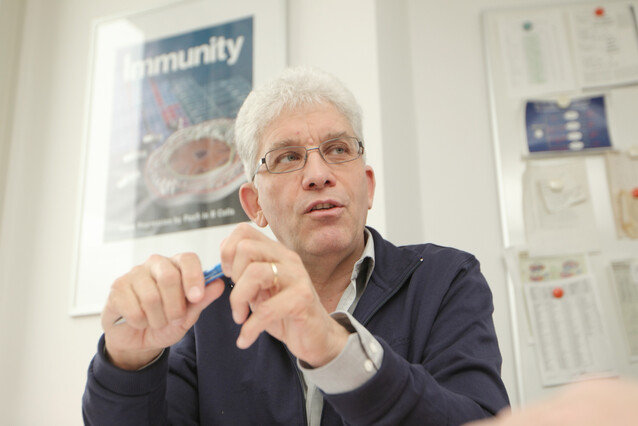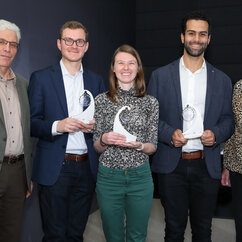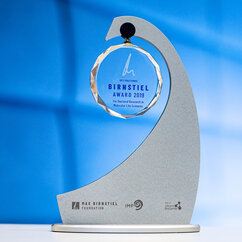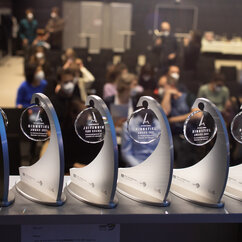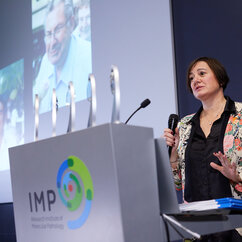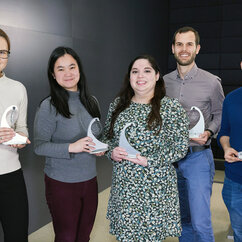Five years of Birnstiel Awards: "Most competitive award of its kind in the World."
In a just over a week, the fifth call of the International Birnstiel Award for Doctoral Research in Molecular Life Sciences will end. Time to reflect on how the award has developed. Meinrad Busslinger, deputy director of the IMP and trustee of the Birnstiel Foundation, has chaired the award since 2019. We joined him for a look behind the scenes.
The call for nominations of the Birnstiel Award will close by the end of this month. 2023 will already be the fifth year that the awards will be presented – which impact has the award had since it was established in 2019?
The awards are a celebration of early achievements in the molecular life sciences. We hope that a Birnstiel Award helps to boost the careers of talented young colleagues. And this seems to be the case: there are now several institutions that nominate their best student of the previous year in every call; we know of institutions that have set up panels to screen students each year specifically for the Birnstiel nomination. So we definitely have developed a bit of a name for the award. And we hope to build on this further.
Then there is of course the impact of the recognised research. It is still a bit early to cast judgement on this, but what we see is that many laureates and honourable mentions continue stellar academic careers – many of whom will undoubtedly contribute important work to their fields.
And finally, the Birnstiel Awards have helped us in our effort to preserve the memory of Max Birnstiel. There are even people here at the Vienna BioCenter who did not know that Max Birnstiel was the first person to purify a single gene – such a milestone event in the history of molecular biology! The Birnstiel Awards have helped us raise awareness for this legacy.
The family of Max Birnstiel also keeps ties with the award.
Correct, the Birnstiel Award is a joint effort of IMP and the Birnstiel Foundation, which was created with the support of the Birnstiel family and IMP alumni. Maggie Birnstiel, the widow of Max and also a biochemist herself, handed out the first prizes in 2019. Unfortunately, she passed away in 2021. But we were happy to welcome their daughter Kirsty to the award ceremony last year. I think these personal links are really valuable to transfer the spirit of the IMP to the award – combining excellence in research with a confined, friendly environment.
How competitive is the award?
Extremely! We urge institutions to nominate only one person per year, and we streamline this by asking nominations to be formally done through directors or heads of academic programmes. We still receive about 100 to 130 nominations, and easily two thirds of those are exceptionally good candidates.
From what we see, the Weintraub Award [of Fred Hutch in Seattle] is similarly popular, but we give only six awards per year. We have to be very selective, so the Birnstiel Award may well be the most competitive award of its kind in the World.
Speaking of the Weintraub Award – do you see big overlaps in nominations?
Surprisingly not – in some cases, we had shortlisted candidates that we saw winning a Weintraub, but so far, we never had somebody win both awards. I think the Weintraub has a stronger base in North America, whereas the Birnstiel Award is most visible in Europe.
That said, this year we made an extra effort to promote the call in Asia, in particular India, China, South Korea, and Japan. All very strong research locations, and yet we have had relatively few nominations from there in the past.
The “International Birnstiel Award for Doctoral Research in Molecular Life Sciences” is open to nominations from anywhere in the world, except for Austria. How come?
The IMP has always seen itself as an international institution in Vienna. Most scientists have had transnational careers, often international families, and we wanted to emphasise the global scope of the award by explicitly going beyond Austria. There are several prizes in Austria that are available for institutions in this country, and we wanted to build on this by adding an international award presented here.
That said, Austrian nationality is of course no obstacle. We have had several nominations of Austrian scientists at institutions abroad, and in 2021, we even had an Austrian laureate, Fanny Matheis – nominated by her institution, the Rockefeller University in New York City.
Gallery: Five years of Birnstiel Awards
How has the award changed over the years?
Well, the biggest change followed immediately after the creation of the award. In the first year, we were overwhelmed with the sheer number of really, really exceptional PhD students in the nominations – and we had planned to give only three awards. We set up an honourable mentions list to have at least some way to give a nod to deserving nominees whom we could not give an award. This list became a tradition. For the years from 2020, we extended our awards to six - although we usually say “up to six”, to maintain some flexibility.
Then came Covid, making it impossible to hold an award ceremony. This was quite a shame, because showing the laureates the IMP and giving them a chance to interact with scientists at the Vienna BioCenter is a central part of the experience. In 2021, we had a small ceremony in the midst of a lockdown – luckily, professional travel was exempted from the restrictions. Since last year, we are back to a normal operational mode.
We still try new things – last year, for example, we nominated two people from among previous laureates and honourable mentions to give presentations on their postdoc work. We are exploring ways in which we can keep in touch with our “award alumni”.
How are nominees selected?
Each year, we have a selection committee of four principal investigators, grouped in pairs. In a first step, nominations are screened for completeness and eligibility, then they are reviewed. 20 nominations make it to a shortlist, then the committee convenes at the end of summer to select six winners and an unspecified number of deserving “honourable mentions”. The selected people, their supervisors, and nominees are informed and one or two weeks later, we announce the awards publicly.
Are there preferences in topics or other biases?
Half of the selection committee in each year are women, which reflects that almost exactly half the nominees are also female – laureates so far as well, by the way. Topic-wise, the award is open to the entire field of molecular life sciences; if nominations are beyond the expertise of the selection committee members, they often consult colleagues from the IMP or its neighbouring institutes at the Vienna BioCenter. I cannot rule out that subjects studied at the IMP will have an advantage over fields that are not, such as clinical research or plants biology. But we try to judge as objectively as possible, and on grounds of impact, significance, and merit of the nominee.
Laureates typically have several publications, including in high-impact journals. Do nominations without a “Cell/Nature/Science” paper stand a chance?
We do our best to judge the science and not the journal. We encourage the use of preprints – keep in mind that manuscripts are often not published at the time of the nomination. And many of the most important discoveries in molecular biology were published in journals with lower impact factors than CNS. That said, authors of obvious big breakthroughs generally target the most reputable publication with the biggest audience, which might explain why most of our laureates have published in such journals – at least by the time the awards are announced. Some of their nominations still have included preprints.
How do you think the award will develop in the future?
As for the award itself, I think this is clear: as long as nominations remain as competitive as now, the reputation of the ward will only grow, and we will continue to choose from the cream of the crop. The commitment of IMP and Birnstiel Foundation to continue with the Birnstiel Award in the long term is clearly there, so I believe the future of it is bright.
We should now see how we can develop the growing group of past laureates into a network– perhaps there is potential for them to form a community, to benefit the award, themselves, and the rising talent that the Birnstiel Award seeks to celebrate. And I think it would be good to further push for visibility beyond Europe.
Further Reading
